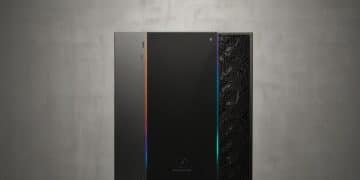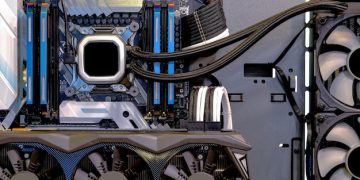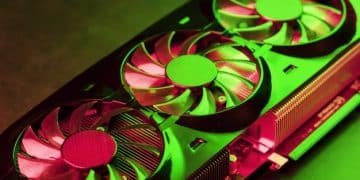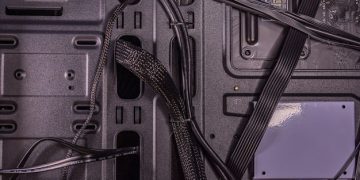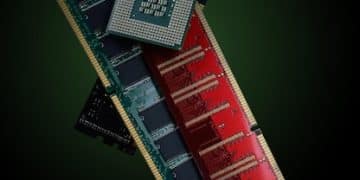Building a Silent Gaming PC: Components & Noise Reduction Techniques
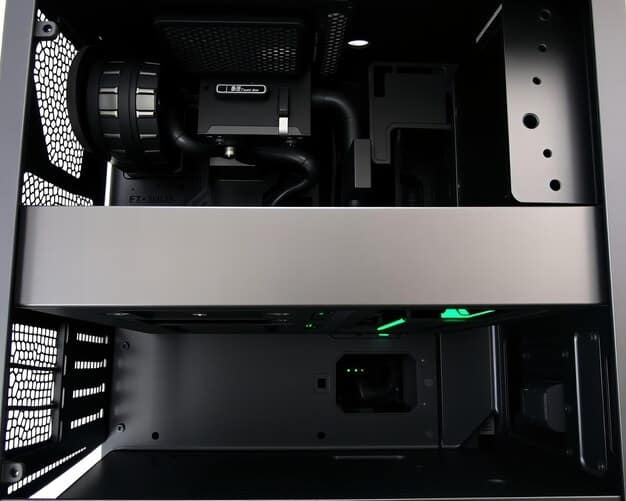
Building a silent gaming PC involves selecting components like cases, coolers, and power supplies designed for minimal noise, along with implementing acoustic dampening techniques to create a near-silent gaming experience.
Are you tired of the constant whirring and buzzing of your gaming PC drowning out your game audio? Building a silent gaming PC is achievable with the right components and techniques, ensuring an immersive and distraction-free gaming experience.
Choosing the Right Case for a Silent PC
Selecting the right case is the first step in creating a silent gaming PC. The case acts as the foundation for your build, influencing airflow and noise containment. Cases designed for silence often include features like sound-dampening materials and optimized airflow to minimize noise while maintaining adequate cooling.
Sound Dampening Features
Cases designed for silent builds incorporate sound-dampening materials on their panels to absorb and reduce noise. These materials can significantly lower the overall sound output of your PC.
Optimized Airflow
Effective airflow is crucial for keeping components cool without relying on noisy fans. Look for cases with well-designed airflow paths that allow for efficient heat dissipation at lower fan speeds.
- Case Material: Opt for cases with thick steel or aluminum construction, as they tend to dampen vibrations more effectively than cheaper, thinner materials.
- Fan Placement: Consider cases that allow for multiple fan placements, giving you the flexibility to optimize airflow and cooling.
- Dust Filters: Effective dust filters not only keep your components clean but can also help reduce noise by preventing the need for fans to spin at higher speeds to compensate for dust buildup.
In summary, a well-chosen case with sound-dampening features and optimized airflow is essential for a silent gaming PC build. It provides a solid foundation for minimizing noise while ensuring adequate cooling.
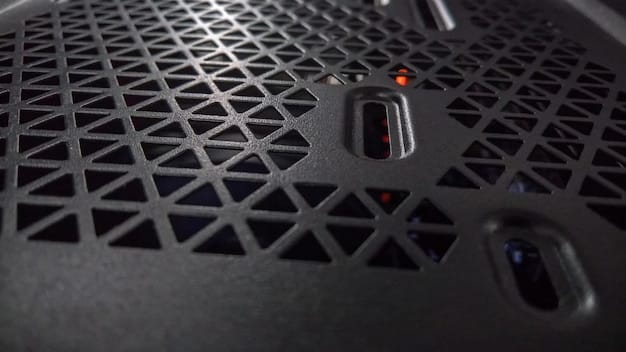
Selecting a Quiet CPU Cooler
The CPU cooler is a critical component for managing heat, and it can also be a significant source of noise. Choosing a quiet CPU cooler involves considering both its cooling performance and its noise level. There are two primary types to consider: air coolers and liquid coolers.
Air Coolers
Air coolers use heatsinks and fans to dissipate heat from the CPU. High-quality air coolers designed for silence often feature large heatsinks and slow-spinning fans.
Liquid Coolers
Liquid coolers, also known as all-in-one (AIO) coolers, use a radiator and liquid to transfer heat away from the CPU. While they can be very effective at cooling, they also have the potential to introduce noise through pump vibrations and fan noise on the radiator.
- Fan Size and Design: Opt for coolers with larger fans (120mm or 140mm) that can move more air at lower RPMs, reducing noise.
- Heatsink Design: Look for coolers with dense fin stacks to maximize heat dissipation with minimal airflow.
- Pump Noise: If choosing a liquid cooler, research models known for having quiet pumps, and consider mounting the radiator with vibration-dampening materials.
In essence, the CPU cooler plays a vital role in maintaining optimal temperatures while minimizing noise output. By selecting a cooler with attention to fan size, heatsink design, and pump noise (for liquid coolers), you can achieve effective cooling without compromising silence.
Choosing a Silent Graphics Card
The graphics card is often one of the loudest components in a gaming PC, especially during intense gaming sessions. Selecting a graphics card designed for silent operation is crucial for creating a quiet gaming experience. Look for models with advanced cooling solutions and quiet fan designs.
Passive Cooling
Some graphics cards are designed with passive cooling, using large heatsinks without any fans. These cards are completely silent but may not be suitable for high-performance gaming due to their limited cooling capacity.
Advanced Fan Designs
Most high-performance graphics cards use fans for cooling, but many manufacturers have developed advanced fan designs that minimize noise. These designs often include features like custom fan blades, optimized heatsinks, and the ability to stop the fans completely at idle or low temperatures.
- Heat Pipe Technology: Graphics cards with multiple heat pipes can efficiently transfer heat away from the GPU, allowing fans to spin at lower speeds.
- Fan Stop Technology: Many modern graphics cards feature fan stop technology, which completely stops the fans when the GPU temperature is below a certain threshold, resulting in silent operation during light workloads.
- Custom Fan Profiles: Use software like MSI Afterburner or EVGA Precision X1 to create custom fan profiles that prioritize quiet operation while maintaining acceptable temperatures.
In conclusion, a silent graphics card is essential for a quiet gaming setup. Opting for models with passive cooling, advanced fan designs, or the ability to customize fan profiles can significantly reduce noise levels during gaming.
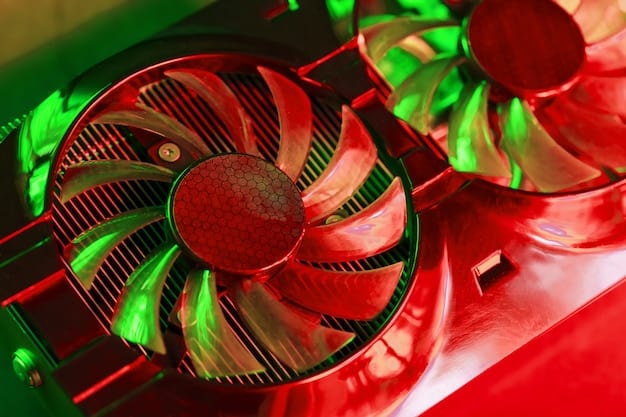
Selecting a Quiet Power Supply
The power supply (PSU) is an often-overlooked component when building a silent PC, but it can contribute significantly to overall noise levels. Selecting a PSU designed for silence involves considering its efficiency, fan design, and overall build quality. A high-quality, efficient PSU will generate less heat, reducing the need for aggressive fan cooling.
Efficiency Ratings
PSUs are rated for efficiency using the 80 Plus certification system. Higher efficiency ratings, such as 80 Plus Gold, Platinum, or Titanium, indicate that the PSU wastes less energy as heat, reducing the need for fan cooling.
Fan Types and Control
Many PSUs use fans for cooling, but the type and design of the fan can significantly impact noise levels. Look for PSUs with fluid dynamic bearing (FDB) fans, which are known for their quiet operation and long lifespan.
- Fanless PSUs: Consider fanless PSUs for completely silent operation. These PSUs rely on large heatsinks for cooling and are suitable for systems with moderate power requirements.
- Hybrid Fan Mode: Some PSUs feature a hybrid fan mode, where the fan remains off until the PSU reaches a certain temperature threshold. This allows for silent operation during light workloads.
- PSU Placement: Ensure the PSU has adequate ventilation in your case. Avoid blocking the PSU fan with cables or other components.
To summarize, selecting a quiet power supply is crucial for minimizing noise in your gaming PC. By considering efficiency ratings, fan types, and control options, you can ensure that your PSU operates quietly and efficiently.
Implementing Acoustic Dampening Techniques
In addition to selecting quiet components, implementing acoustic dampening techniques can further reduce noise levels in your gaming PC. These techniques involve using materials and methods to absorb and block sound from escaping the case. Effective acoustic dampening can significantly reduce the overall noise profile of your system.
Sound Dampening Materials
Applying sound dampening materials to the inside of your PC case can absorb vibrations and reduce noise. These materials are typically made from foam, rubber, or other sound-absorbing materials.
Cable Management
Proper cable management can improve airflow and reduce vibrations. Bundling and routing cables away from fans and other components can help minimize noise.
- Vibration Dampeners: Use rubber grommets and vibration dampeners on fans and hard drives to reduce noise caused by vibrations.
- Solid State Drives (SSDs): Replace traditional hard drives (HDDs) with solid state drives (SSDs). SSDs have no moving parts and are completely silent.
- Fan Speed Controllers: Use fan speed controllers to manually adjust fan speeds based on temperature, allowing you to prioritize silence over maximum cooling performance when appropriate.
In short, acoustic dampening techniques are essential for maximizing noise reduction in your gaming PC. By using sound dampening materials, practicing good cable management, and employing vibration dampeners, you can create a truly silent gaming experience.
Optimizing Fan Placement and Speed
Proper fan placement and speed optimization are crucial for maintaining efficient cooling while minimizing noise. Strategic fan placement can create positive or negative pressure within the case, influencing airflow and cooling performance. Adjusting fan speeds based on temperature can help balance cooling and noise levels.
Positive vs. Negative Pressure
Positive pressure occurs when there are more intake fans than exhaust fans, creating a higher pressure inside the case. This can help prevent dust from entering through unfiltered openings but may result in slightly higher temperatures.
Fan Speed Control
Controlling fan speeds based on temperature can significantly reduce noise levels. Use software or hardware fan controllers to adjust fan speeds based on CPU and GPU temperatures.
- Fan Curves: Create custom fan curves that prioritize low fan speeds at idle and gradually increase speeds as temperatures rise.
- Fan Placement for Hot Components: Ensure that fans are positioned to directly cool hot components like the CPU and GPU.
- Regular Cleaning: Regularly clean dust from fans and heatsinks to maintain optimal cooling performance and prevent the need for fans to spin at higher speeds.
To sum up, optimizing fan placement and speed is vital for balancing cooling efficiency and noise reduction. By understanding the principles of positive and negative pressure and using fan speed control effectively, you can maintain a quiet yet well-cooled gaming PC.
| Key Point | Brief Description |
|---|---|
| 🔇 Silent Case | Choose cases with sound dampening and optimized airflow. |
| ❄️ Quiet CPU Cooler | Opt for large fans or liquid coolers with quiet pumps. |
| graphic card | Select models with passive cooling or advanced fan designs. |
| ⚙️ Acoustic Dampening | Use materials to absorb vibration and minimize noise |
[Frequently Asked Questions]
▼
The case is arguably the most important, as it houses all components and can greatly reduce noise output. Features like sound-dampening materials are key.
▼
Liquid coolers can be quieter, but it depends on the pump and fan quality. High-quality air coolers can be just as silent and sometimes more reliable.
▼
Cable management is crucial as it improves airflow. Proper routing prevents cables from obstructing fans, reducing the need for high fan speeds.
▼
Fluid Dynamic Bearing (FDB) fans are typically the quietest and most durable option for PC fans, providing long-lasting and silent performance.
▼
Yes, you can replace noisy components with quieter alternatives, add sound dampening materials, and optimize fan speeds to reduce the noise significantly.
Conclusion
Building a silent gaming PC is a worthwhile endeavor for those seeking a more immersive and less distracting gaming experience. By carefully selecting components designed for quiet operation and implementing acoustic dampening techniques, you can create a system that delivers high performance without the noise.

